Christmas time is candy time, and do you know what the ultimate Christmas candy is? No, not fudge…not candy canes…certainly not red and green candy corn. It’s Turkish Delight! with it’s gem-like bright colors and snowy coating of powdered sugar. You’ve never heard of Turkish delight? Never tried it? It’s…well, it’s delightful. Turkish delight is an amazing confection to make for gifts to friends and neighbors or as a jewel on a holiday dessert buffet. Of course, you’ll need your trusty Thermapen® to make it right, as well as some good stirring muscles, but with those two tools, you’ll soon be making Turkish delight that’s tasty enough to make you want to betray your siblings to an evil queen of perpetual winter.
Contents:
What is Turkish delight?
Turkish delight is a jelly-like confection made from cornstarch and sugar, traditionally flavored with rosewater and nuts, especially pistachios or hazelnuts. Turkish delight does actually hail from Turkey, where, not surprisingly, it is not called ‘Turkish delight’ but Lokum. Lokum derives from a Turkish word meaning ‘morsel’ or ‘mouthful,’ describing the sweet bites that have bedecked the windows and storefronts of Turkish shops since the 1700s.
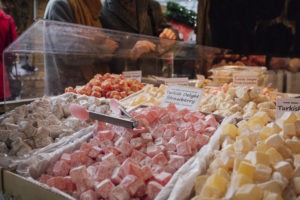
Turkish delight is well beloved in England and around the Mediterranean and known to most Americans only through the book The Lion, the Witch, and the Wardrobe from when the White Witch offers it to one of the children. It is unique for its firm-yet-yielding texture that provides an addicting bite. The traditional rosewater flavoring can be off-putting for many Americans, but that needn’t stop you from making this treat. You can substitute any water-soluble flavoring you like for the rosewater. Orange flower water is also traditional but is still too floral for many. Use an extract such as lemon, orange, or peppermint. Almond extract would be delicious, or you could even try root beer extract. Extracts tend to be quite strong, so use less than the amount of rosewater we use—½–1 tsp would be a good place to start.
The customizability of Turkish delight is nearly endless. Grate some orange zest into it or use toasted, chopped pecans instead of pistachios. Add some chopped dates or, for an added jewel-like beauty, chopped dried apricots. It may have started as the delight of the Turks, but it’s all yours now!
How Turkish delight is made: thermal principles
Lokum is made by combining hot sugar syrup with a thickened cornstarch mixture and cooking it slowly to allow the mixture to thicken and partially dehydrate. Let’s take a closer look at what’s happening here.
Sugar syrup
As with all candy making, Turkish delight starts with a sugar syrup, in this case cooked to a hard-ball stage at 260°F (127°C), which is best measured with a highly-accurate Thermapen. What does hard-ball stage mean? Good question!
The stages of candy making are best measured by temperature but are actually measures of sugar concentration. Most people don’t have pocket hygrometers in their kitchens to measure sugar concentration, but it so happens that there is a correlation between sugar concentration and boiling temperature. The more sugar there is in a solution, the higher the boiling temperature.
| Stage | Temperature | Sugar concentration | Common uses |
|---|---|---|---|
| Thread | 230°-234°F | 80% sugar | thick syrup |
| Soft-ball | 235°-240°F | 85% sugar | fudge |
| Firm-ball | 245°-249°F | 87% sugar | caramels |
| Hard-ball | 250°-265°F | 92% sugar | divinity, nougat |
| Soft-crack | 270°-290°F | 95% sugar | saltwater taffy |
| Hard-crack | 300°-310°F | 99% sugar | toffee, brittles |
| Caramel | 320°-350°F | 100% sugar | varying colors and flavors of caramel |
As you boil a sugar syrup, its temperature will increase as you drive water out of the solution. Measuring the sugar temperature while you cook will tell what your sugar concentration is. How a syrup behaves while making candy will vary greatly depending on its concentration, and you can see how narrow the margins of error are on some of those stages (four degrees Fahrenheit). That’s why an accurate thermometer is absolutely essential. The Thermapen really is the best candy thermometer around, with its super-fast response time and ±0.7°F (±0.4°C) accuracy, you can be sure you are hitting those narrow targets correctly. Getting that candy stage right is very important for all candy, not just Turkish delight!
Starches
Starch is what separates Lokum from other candies. It’s not as sticky as taffy, nor as hard as a lollipop, and not as fluid as a caramel sauce. Its bouncy spring—unattainable by using sugar alone—is the result of copious amounts of starch. What is the starch actually doing in there, though?
As we’ve mentioned in other posts, starch granules are tightly packed balls of starch strands that, when heated in the presence of water, expand and rupture into their individual component strands. These strands disperse through the water, creating greater viscosity.
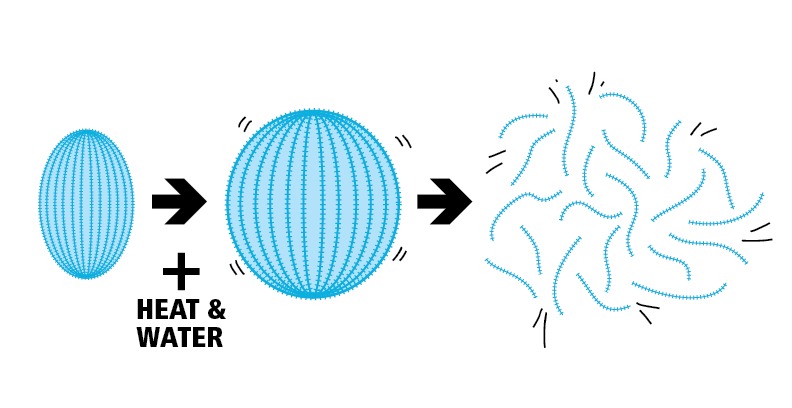
That dispersal of starch is part of what makes this candy spongy. The rest comes from the cooling. As starch mixtures cool, the arms of the starch molecules link up, forming semi-crystalline bonds, trapping liquid in the spaces between them. In the case of Turkish delight, there is so much starch that the candy is transformed from a liquid phase into a semi-solid colloidal phase. The water that it contains is suspended in a net-like weave of starch molecules that is so thick, the whole thing becomes bouncy and resilient.
Bringing it together
To make Turkish delight, cook the syrup to 260°F (127°C), while also cooking a solution of cornstarch and water. The starch mixture will first become kind of gluey and not very appetizing looking. Add the hot syrup to the starch mixture and stir it over low heat. The sugar syrup will eventually combine with the starch mixture, creating a golden, gooey viscous liquid. As it cooks, it will begin to thicken even more. Keep stirring. You need to heat it slowly over the course of about 35-45 minutes to slowly cook out enough water to thicken it to its final density. That’s a lot of thickening.
Can you cook it to a simple doneness temperature? Not really. You see, solution concentrations in water are only measurable by temperature when the solution is boiling, and we can’t boil this solution because it is too thick to boil without burning. We just stir it over low heat, scraping the bottom of the pan frequently, until we’ve driven off enough water to make a paste.
You’ll need to stir the mixture well every few minutes through the whole cook until the syrup mixture begins to aggregate into a mass that can at least partially be pulled up from the bottom of the pan. Only then are flavors, colors, and nuts added.
Note on candy temperatures:
All candy recipes are written at sea level. As discussed above, syrup boiling temperatures equate to sugar concentrations. But at higher elevations, water boils at lower temperatures, meaning water exits the solution sooner. And that means that candy temperatures need to be lowered. For every 1,000 ft above sea level at which you are cooking, reduce the boiling temperature by 2°F [1.1°C]. In the pictures below you’ll see that out Thermapen isn’t reading the listed temperatures, that’s because we’re cooking at about 4,000 ft, and thus subtracting 8°F (4°C) from the recipe temperatures.
Turkish Delight Recipe
Based on Non-Evil Turkish Delight by Liz Gutman and Jen King on Epicurious.com
Ingredients
For the sugar syrup
- 3 C granulated sugar
- 1/2 C honey
- 1/2 C water
- Pinch of cream of tartar
For the cornstarch mixture
- 1 C cornstarch
- 1 C powdered sugar
- 2 1/2 C water
- 1 tsp cream of tartar
For the flavoring
- 2 1/2 tsp rosewater (or another flavoring to your taste)
- 2 C shelled roasted unsalted pistachios (about 1 pound pre-shelling)
- 2 or 3 drops red or other color food coloring (optional)
For cutting and dredging
- About 1/4 C powdered sugar, for dusting the cutting board
- 1/2 cup cornstarch sifted together with 1 cup powdered sugar
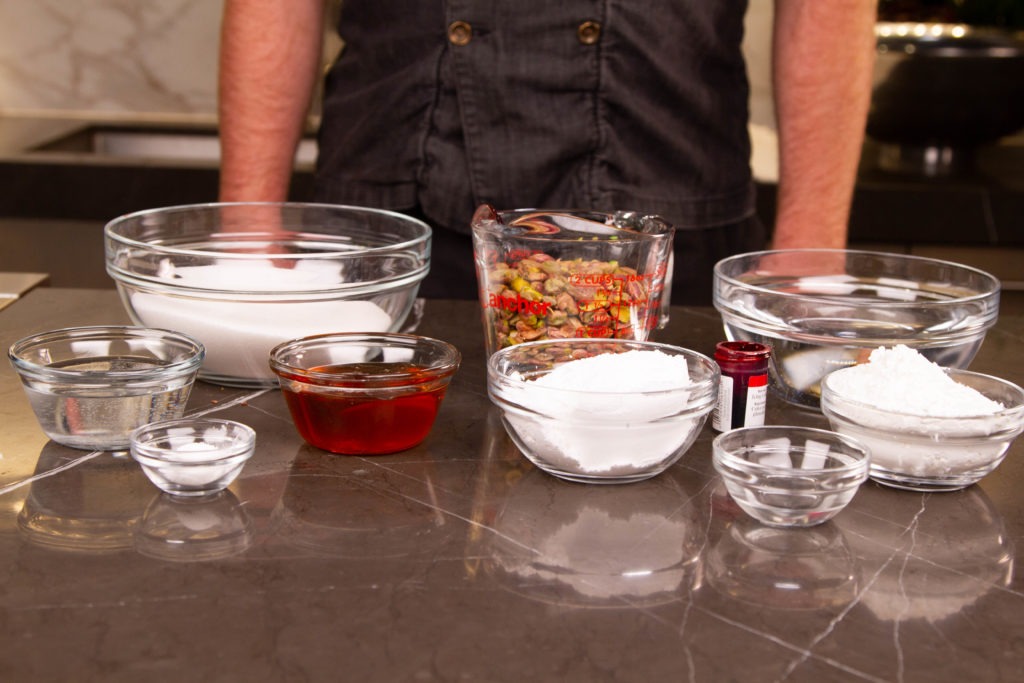
Instructions
- In a 4 quart, heavy-bottomed saucepan, combine the sugar, honey, water, and cream of tartar for the syrup.
- Stir to combine over medium-high heat, then cook to dissolve and boil without further stirring.
- Brush down any sugar crystals on the sides of the pan to prevent crystallization.

- In another large pan (at least 6 quarts), combine the cornstarch, powdered sugar, cream of tartar and water, but don’t cook it yet.

- The syrup will be done cooking at 260°F (127°C) (adjusted for altitude). But to be sure the everything is ready to combine at the same time, start cooking the starch mixture when the syrup reaches 245°F (118°C).
- When the boiling syrup reaches 245°F (118°C), start cooking the starch mixture over high heat, whisking constantly. It will suddenly turn thick and gluey. Kill the heat.

Our elevation-adjusted temp for this step is 237°F, 245°F is the sea-level temp. - When the sugar syrup reaches 260°F (127°C) on your Thermapen, pour it into the starch goop, whisking as you do so.
- Whisk and stir the mixture of the syrup and the starch over medium heat until it is smooth and comes to a low boil.

- Lower the heat and stir with a sturdy spatula or wooden spoon for 35-35 minutes until it forms a mass that can pull away from the sides of the pot and is a pale, light amber color.
- Stir in the rosewater or other flavorings, the food coloring, and the nuts.

- Pour/flop the mixture out into a well-greased 9×13” pan and smooth it out evenly.
- Cover the pan with plastic wrap to prevent a skin from forming.

- If you have a pan that will nest inside of it, place a second pan on top. This is purely cosmetic and will result in a flatter top on the candy.
- Allow the Turkish delight to rest overnight on the countertop.
- To cut, first dust a cutting board generously with powdered sugar.
- Peel off the plastic wrap and run a knife around the edge of the pan to loosen the candy, and turn it out onto the cutting board.

- Use a sharp knife sprayed with cooking spray to slice the jelly into 1” chunks. You’ll need to re-spray the knife between each cut.

- In a bowl, sift together the cornstarch and the powdered sugar for dredging.
- Place a few pieces of Turkish delight in the mixture and toss them to coat.

- Tap the pieces on the cutting board to remove excess powder.
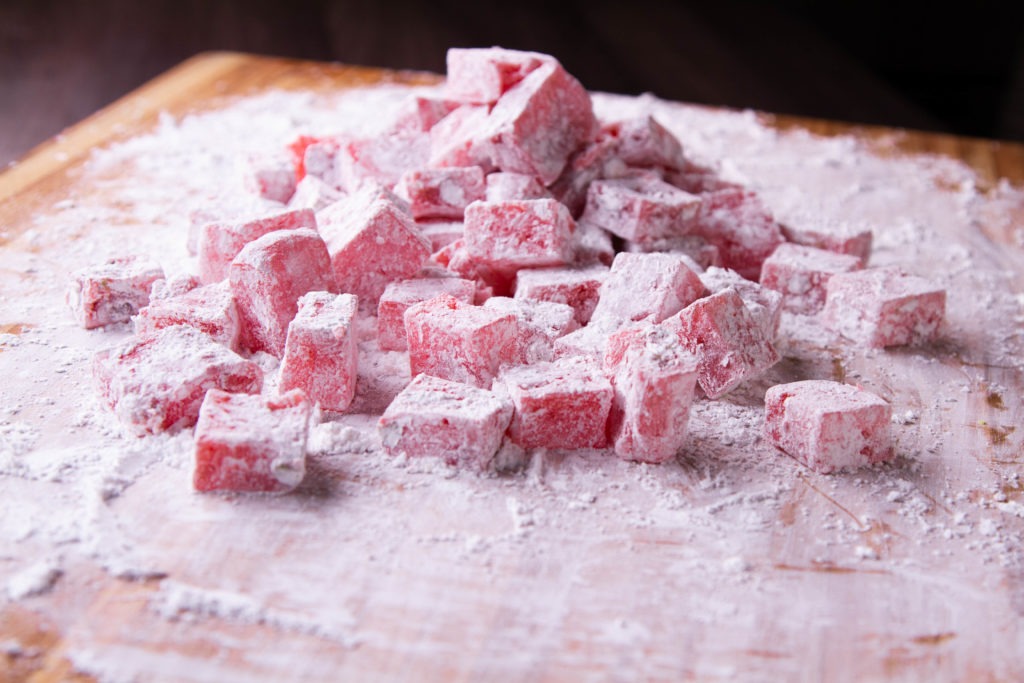
- Serve or store in a tightly sealed container for 1-3 weeks.
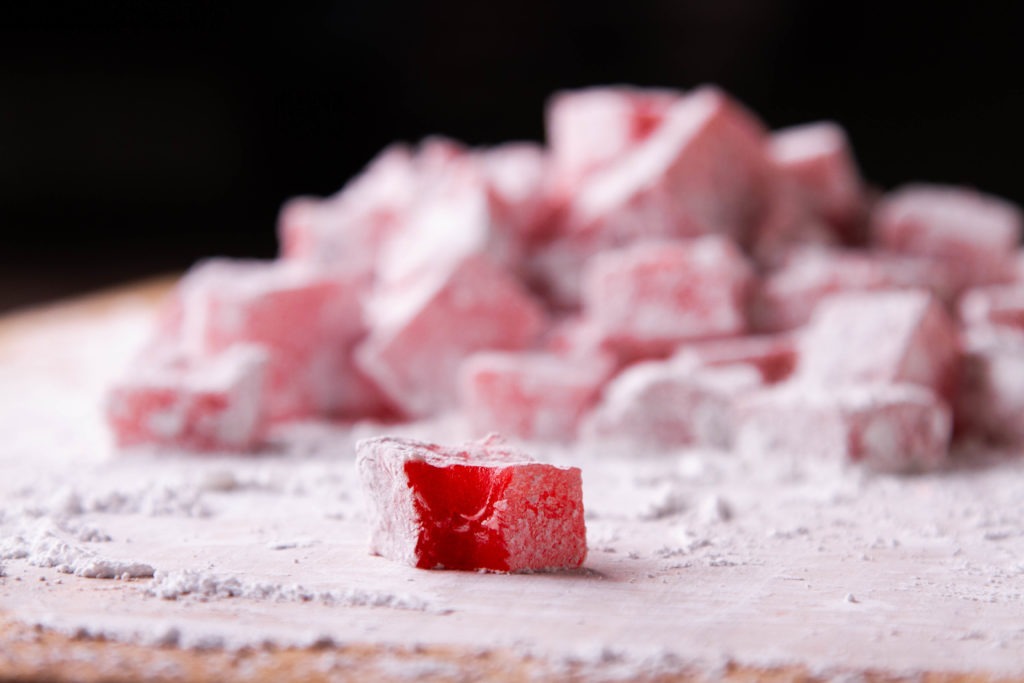
With gorgeous, gem-like colors of red candy and bright green pistachios, these frosty-looking candies are a perfect Christmas-time candy to share with friends and family. Aside from the stirring, it’s an easy candy that even novice confectioners can master—as long as you monitor those syrup temperatures with your Thermapen.
Shop now for items used in this post:

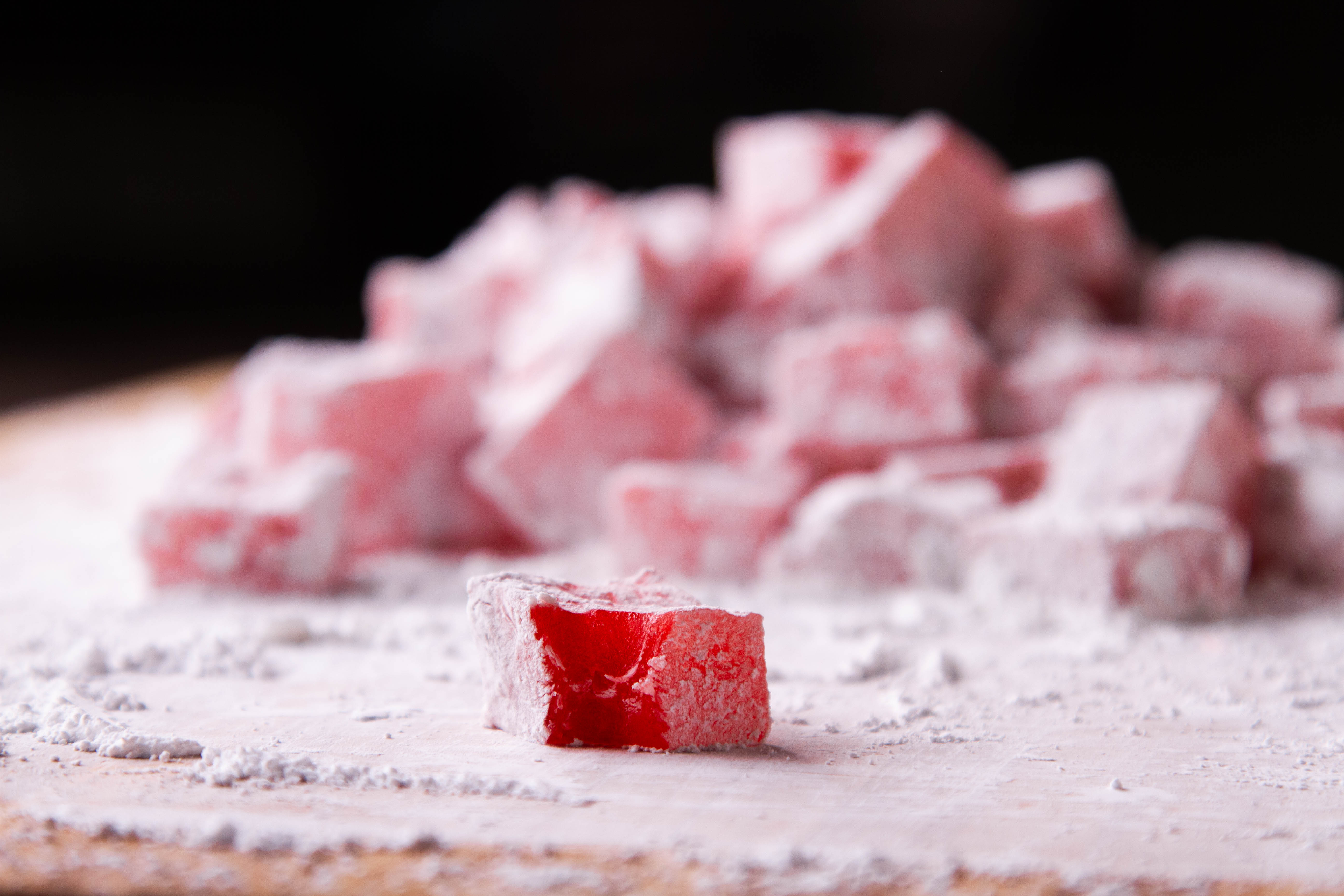
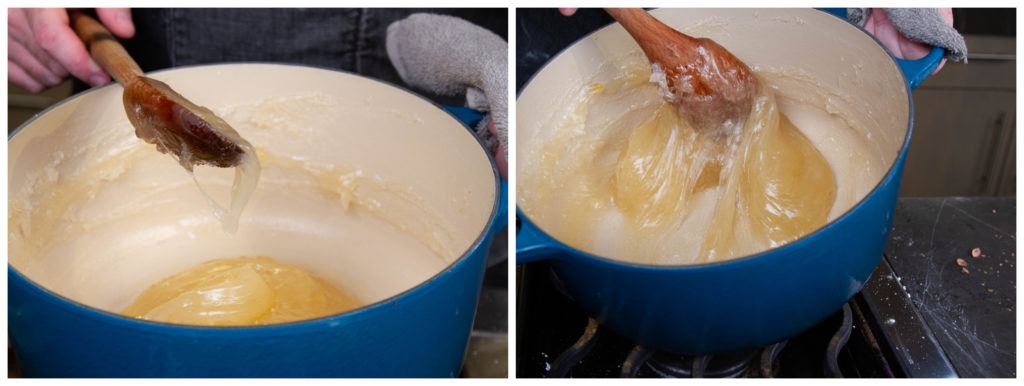

Cristian Rivera says
Thanks for sharing, the temperature explanation and history of the candy make this blog entry a pleasure to read. If I want to make caramel for a flan…what temperature my sugar should hit??? Thanks again????????
Martin says
Cristian,
Flan caramel is cooked all the way to the caramel stage, at or beyond 320. The further you cook it, the deeper the flavor and color, but also the closer to burnt. 330 is a nice safe bet.
Happy cooking!
Julie says
I grew up enjoying candy called “Aplets” and “Cotlets”. The texture reminds me of this candy description but the flavor was apple or apricot and the nuts were walnuts I think. I would like to try making your TurkishDelight. And I wonder if somehow I could figure out how to duplicate the candies of my childhood.
Karen says
You might mention never to use an aluminum pot (a non-stick finish). I remember my first attempt at “rahat halkum” as a young bride in 1975; I knew my way around a kitchen and couldn’t understand why it wouldn’t thicken. Turns out it was the aluminum pot.
Tom says
Question:
My wife uses my Thermapen for cooking candy, but would like to have a temperature probe clipped to the side the whole time so she can free up one hand and be constantly measuring the temperature…….What should we buy from you for this?…Perhaps a Thermodot and a long probe (Which probe for 4 or 5 qt. pan?)? We already have your “timer/thermoprobe” that we use for the turkey, etc but would like to have a dedicated set for candy making.
Thanks!….And keep up the great work!
Martin says
Tom,
Thanks for the question. First, I’d recommend reading our post on the best candy thermometers. Though it is an annoyance, the Thermapen really is the best choice. That being said, If you do want to use something else that will free up your hands, the ChefAlarm is the best bet. Let me know if you have any questions!
Kathleen Holcomb says
I think I should have sifted the cornflour and powdered sugar. I think I have lumps, though I won’t know for a while. I hope it’s done—but it smells like roses!
Bear says
I’m confused – my Joy of Cooking’s recipe for Turkish Delight is based on gelatin or alternatively fruit pectin. Is this something different?
Martin says
Bear,
The most traditional versions of the dish are made with starch. Pectin would be the closest analog, but I’d shy away from gelatin, as the texture may end up more like a gummy than Turkish delight.
Jomarie says
Is honey a traditional ingredient? If so what honey would be best?
Martin says
Honey is not traditional, but we like the flavor. Wildflower honey is very popular in Turkey, and a honey that reflects that non-homogenous origin would be closest to what they would use, if they were to use it.